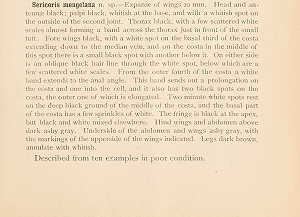Länder:

 +2Kontinente:EUNA
+2Kontinente:EUNA


 +2Kontinente:EUNA
+2Kontinente:EUNANeues Layout der Navigation (Beta Test)
LebendfotosFalterDiagnoseBiologieNahrung der RaupeWeitere InformationenAndere KombinationenSynonymeFaunistikLiteraturInformationen auf anderen Websites (externe Links)
2. Diagnose
2.1. Erstbeschreibung
1: Fernald (1894: 131) [nach Copyright-freiem Scan auf www.biodiversitylibrary.org]
3. Biologie
3.1. Nahrung der Raupe
- [Rosaceae:] Dryas integrifolia
Karsholt et al. in Böcher et al. (2015: 318) schreiben: "The hostplant in Canada is Dryas integrifolia. Larva of A. mengelana probably have a life cycle of 2 years (Mackay & Downes 1969). Adults fly from early June to early August. They fly in dry, sunny places with Cassiope Vegetation (Nielsen 1910: 67)."
4. Weitere Informationen
4.1. Andere Kombinationen
- Sericoris mengelana Fernald, 1894 [Originalkombination]
4.2. Synonyme
- Penthina groenlandicana Bang-Haas, 1896
4.3. Faunistik
Locus typicus: Nord-Grönland, McCormick Bay, 77° 42' N
Nach der [Fauna Europaea] kommt die Art auf Nowaja Semlja (Russland) vor. Kullberg et al. (2018/2019) nennen dazu als einzigen Nachweis eine auf Rebel (1923) zurückgehende Meldung vom 19. August 1921 von Belushja Guba.
(Autor: Erwin Rennwald)
4.4. Literatur
- Böcher, J.J., Kristensen, N.P., Pape, T. & L. Vilhelmsen (2015): The Greenland Entomofauna. An Identification Manual of Insects, Arachnids and their Allies. — xvi, 881 S.; Leiden (Brill). [zitiert nach Seiten von Google-books)
- Erstbeschreibung: Fernald, C. H. (1894): North Greenland Microlepidoptera. — Entomological News and Proceedings of the Entomological Section of the Academy of Natural Sciences of Philadelphia 5: 129-132.
- Kullberg, J., Filippov, B.Yu., Spitsyn, V.M., Zubrij, N.A. & M.V. Kozlov (2018/2019) [Published online: 1 November 2018]: Moths and butterflies (Insecta: Lepidoptera) of the Russian Arctic islands in the Barents Sea. Faunistic notes on Lepidoptera collected from arctic Tundra in European Russia. — Polar Biology, 42 (2): 335–346. [https://doi.org/10.1007/s00300-018-2425-z] [Zur Arbeit und zum PDF-Download auf link.springer.com].
4.5. Informationen auf anderen Websites (externe Links)
- [BOLD Systems] dort unter Olethreutes mengelana zu finden
- [Moth Photographers Group]





